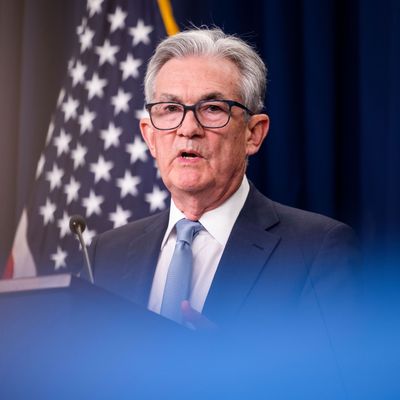
Listen long enough to Jerome Powell, the chair of the Federal Reserve, and you’re likely to hear him tell you that the central bank doesn’t act so much as it reacts. At a press conference in Washington, D.C., Powell framed the central bank’s Wednesday interest-rate hike of 0.75 percent — the biggest increase since 1994 — as a response to the rapidly deteriorating economic conditions of the U.S., particularly the higher inflation numbers and worse consumer sentiment that came out last week. When asked about the future, he hedged. “This is a highly uncertain environment, an extraordinarily uncertain environment,” Powell said. “We will be determined and resolved — but flexible.” There may be other similarly large and sudden jerks to the money supply in coming months, he said, but he’d have to wait for the data. It’s in stark contrast to the last time the Fed made such a move — with then-Fed chair Alan Greenspan rapidly tightening the money supply as a “preemptive strike” against an inflation threat that had hardly started to materialize.
And so we, the U.S. consumer, wait and hope for the best — and it could be years before things get better. What’s extraordinary isn’t really the size of the hike — it was telegraphed via a Wall Street Journal article on Monday — but how long the central bank thinks this period of economic doom and gloom will last. According to projections from the bank’s own board of governors, it could be 2024 before inflation has cooled off enough that it could start to ease rates lower again, with or without a recession. Before then, interest rates are likely to double — remember, the higher they get, the more painful it becomes to borrow and spend — and then some into next year. So if you think it’s already getting hard to afford your current lifestyle, just wait.
The Fed is a powerful institution, an independent organ of the government that has a nearly unchecked power to create and destroy jobs and credit. It has also, in recent years, been one that’s been reluctant to acknowledge the threats underlying the economic situation. When inflationary pressures started to become apparent last spring, the central bank dismissed them as “transitory.” It was just the result of buying and selling imbalances because of the pandemic and things would sort themselves out, the Fed maintained. This was, after all, the period when COVID vaccines were first getting rolled out, a ridiculously optimistic time when it seemed like the world’s biggest problem was about to vanish. But Powell and his colleagues at the Fed were clearly wrong, as we are now in the worst inflationary environment in 40 years with no real end in sight. To his credit, Powell has clearly internalized the problem of inflation now and appears to be trying to catch up. “The worst mistake we could make would be to fail, which it’s not an option,” he said. “We have to restore price stability. We really do. It’s the bedrock of the economy. If you don’t have price stability, the economy’s really not going to work the way it’s supposed to.”
When we get there isn’t exactly clear. Projections from the Fed can change dramatically. For instance, the central bank governors saw themselves confronting a much easier problem back in March, thinking they’d need fewer interest rate hikes to tame inflation. And the reality is that, despite the power the Fed has, its sphere of influence does not encompass the entire universe. In his press conference Wednesday, Powell noted the Fed’s limitations in solving all the country’s financial problems. The war in Ukraine is inflating oil prices, and COVID policies in China are jamming up supply chains, just to name two large geopolitical problems that Powell has approximately zero influence on.
Sure, the stock market rallied after Powell’s remarks, as Wall Street is hoping the Fed just moves faster and gets the whole inflation thing over with. But can it really work? Geopolitics has killed a decade of market optimism. It’s not hard to see a world where that bleeds into the broader economy, especially if the period of rising prices just keeps going. Consumers are already exhausted, judging by the consumer-sentiment survey that Powell had cited as one reason for the 0.75 percent hike today. The Fed can make it harder to buy cars and homes, curb opulent spending and reliance on debt, and bind businesses so they are forced to cull their workforce — something that’s already becoming apparent. Maybe that can bend inflation down and make it easier for people to live their everyday lives. But Powell’s Fed has been overoptimistic before, and this time, with Russia and China holding the price of U.S. goods in their hands, it’s possible that they still aren’t grappling with the depths of the problem.






























